
IHC-P analysis of human lung carcinoma tissue using GTX86958 CBP (acetyl Lys1535) antibody. The picture on the right is blocked with the synthesized peptide.
CBP (acetyl Lys1535) antibody
GTX86958
ApplicationsImmunoHistoChemistry, ImmunoHistoChemistry Paraffin
Product group Antibodies
TargetCREBBP
Overview
- SupplierGeneTex
- Product NameCBP (acetyl Lys1535) antibody
- Delivery Days Customer9
- Application Supplier NoteIHC-P: 1:50~1:100. *Optimal dilutions/concentrations should be determined by the researcher.Not tested in other applications.
- ApplicationsImmunoHistoChemistry, ImmunoHistoChemistry Paraffin
- CertificationResearch Use Only
- ClonalityPolyclonal
- ConjugateUnconjugated
- Gene ID1387
- Target nameCREBBP
- Target descriptionCREB binding lysine acetyltransferase
- Target synonymsCBP, KAT3A, MKHK1, RSTS, RSTS1, CREB-binding protein, histone lysine acetyltransferase CREBBP, protein lactyltransferas CREBBP, protein-lysine acetyltransferase CREBBP
- HostRabbit
- IsotypeIgG
- Protein IDQ92793
- Protein NameCREB-binding protein
- Scientific DescriptionThis gene is ubiquitously expressed and is involved in the transcriptional coactivation of many different transcription factors. First isolated as a nuclear protein that binds to cAMP-response element binding protein (CREB), this gene is now known to play critical roles in embryonic development, growth control, and homeostasis by coupling chromatin remodeling to transcription factor recognition. The protein encoded by this gene has intrinsic histone acetyltransferase activity and also acts as a scaffold to stabilize additional protein interactions with the transcription complex. This protein acetylates both histone and non-histone proteins. This protein shares regions of very high sequence similarity with protein p300 in its bromodomain, cysteine-histidine-rich regions, and histone acetyltransferase domain. Mutations in this gene cause Rubinstein-Taybi syndrome (RTS). Chromosomal translocations involving this gene have been associated with acute myeloid leukemia. Alternative splicing results in multiple transcript variants encoding different isoforms. [provided by RefSeq, Feb 2009]
- Storage Instruction-20°C or -80°C,2°C to 8°C
- UNSPSC12352203





